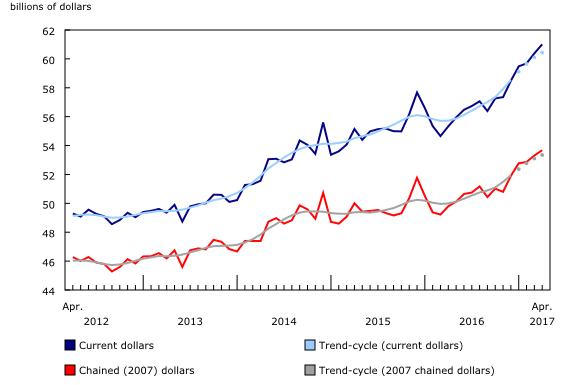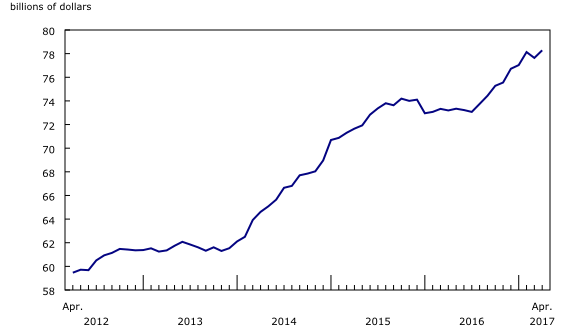Wholesale trade, April 2017
Archived Content
Information identified as archived is provided for reference, research or recordkeeping purposes. It is not subject to the Government of Canada Web Standards and has not been altered or updated since it was archived. Please "contact us" to request a format other than those available.
Released: 2017-06-20
$61.0 billion
April 2017
1.0% 
(monthly change)
$308.3 million
April 2017
-36.3% 
(monthly change)
$74.0 million
April 2017
0.2% 
(monthly change)
$837.6 million
April 2017
3.3% 
(monthly change)
$521.9 million
April 2017
2.7% 
(monthly change)
$11,006.0 million
April 2017
1.4% 
(monthly change)
$31,513.9 million
April 2017
1.3% 
(monthly change)
$1,705.1 million
April 2017
5.4% 
(monthly change)
$2,307.3 million
April 2017
5.4% 
(monthly change)
$6,414.3 million
April 2017
-0.3% 
(monthly change)
$6,226.9 million
April 2017
-0.2% 
(monthly change)
$25.1 million
April 2017
12.0% 
(monthly change)
$59.6 million
April 2017
56.7% 
(monthly change)
$7.3 million
April 2017
-15.7% 
(monthly change)
Wholesale sales increased 1.0% to $61.0 billion in April, a seventh consecutive monthly advance. Gains were recorded in three of seven subsectors, accounting for 41% of total wholesale sales, and were led by the machinery, equipment and supplies subsector.
In volume terms, wholesale sales increased 0.7% from March to April.
Higher sales in three subsectors
The machinery, equipment and supplies subsector recorded the largest gain in dollar terms in April, up 7.3% to $12.4 billion. Higher sales were recorded in three of four industries, with the farm, lawn and garden machinery and equipment, and the other machinery, equipment and supplies industries contributing the most to the gain after both posted declines in March.
Sales in the food, beverage and tobacco subsector rose 1.5% to $11.8 billion, a third consecutive monthly gain. Higher sales in the food industry (+1.4%) contributed the most to the gain.
The motor vehicle and parts subsector recorded a third consecutive decline in April, with sales down 1.7% to $11.3 billion. The motor vehicle industry accounted for most of the decline as sales receded 2.1% to $9.1 billion. Manufacturing sales of motor vehicles also declined in April, down 3.7% to $5.7 billion.
Following a 3.3% increase in March, the miscellaneous subsector declined 1.5% to $7.9 billion, with decreases reported in three of five industries. The chemical (except agricultural) and allied product (-5.1%) and the recyclable material (-8.1%) industries accounted for most of the decline.
The building material and supplies subsector and the personal and household goods subsector both declined 0.7% in April following gains in March.
Sales up in seven provinces
Wholesale sales rose in seven provinces in April, representing 79% of total wholesale sales. In dollar terms, Ontario contributed the most to the gain.
Sales in Ontario rose for a fifth consecutive month, up 1.3% to a record high $31.5 billion in April. The machinery, equipment and supplies subsector was the largest contributor to the gain.
Quebec recorded a second consecutive increase, rising 1.4% to a record high $11.0 billion. Gains were recorded in six subsectors, led by the building material and supplies subsector and the machinery, equipment and supplies subsector.
In Saskatchewan, sales were up 5.4% to $2.3 billion, primarily on higher sales in the machinery, equipment and supplies subsector. This was the province's second consecutive gain.
Sales in Manitoba grew 5.4% to a record high $1.7 billion in April on the strength of gains in three subsectors.
In Nova Scotia, sales grew 3.3% to $838 million, a second consecutive gain. The food, beverage and tobacco subsector and the building material and supplies subsector contributed the most to the gain.
Sales in New Brunswick rose 2.7% to $522 million, with gains in four subsectors. Sales in Prince Edward Island edged up 0.2% to $74 million, with gains in five subsectors. This was the second consecutive increase for both provinces.
Newfoundland and Labrador recorded its first decline in three months, with sales dropping 36.3% to $308 million, more than offsetting a 28.0% gain in March. The miscellaneous subsector was the largest contributor to the decrease.
Following six consecutive gains, sales in Alberta edged down 0.3% to $6.4 billion, led by the motor vehicle and parts subsector.
In British Columbia, sales edged down 0.2% to $6.2 billion, led by the machinery, equipment and supplies subsector. This was British Columbia's third monthly decrease in the past four months.
Inventories increase for the eighth time in nine months
Wholesale inventories increased 0.8% in April, the eighth increase in the past nine months. Five of seven subsectors rose, representing 84% of total wholesale inventories.
The motor vehicle and parts subsector (+1.9%) posted the largest increase in April, a third consecutive monthly gain.
The miscellaneous subsector (+2.1%) recorded the second largest increase in inventories, the subsector's seventh consecutive monthly increase.
The personal and household goods subsector (+1.1%) rose for the fourth time in five months.
The food, beverage and tobacco subsector (+1.7%) recorded its second increase through the first four months of 2017. This subsector recorded gains in each month in the 2016 calendar year.
The machinery, equipment and supplies subsector (+0.3%) rose after recording a 4.2% decline in March.
The building material and supplies subsector (-1.0%) recorded the largest decline in April. This was the subsector's first decline since November 2016.
The inventory-to-sales ratio declined from 1.29 in March to 1.28 in April. The last time the inventory-to-sales ratio was this low was in December 2014, when the ratio was 1.24. This ratio is a measure of the time in months required to exhaust inventories if sales were to remain at their current level.

In celebration of the country's 150th birthday, Statistics Canada is presenting snapshots from our rich statistical history.
"Wood was the staple of Canadian trade for much of the 19th century," states The Canadian Encyclopedia. "Fueled by European demand, the timber trade brought investment and immigration to eastern Canada, fostered economic development, and transformed the regional environment far more radically than the earlier exploitation of fish and fur."
By 1930, wholesalers who were part of the lumber and building materials industry had sales that amounted to $52 million, accounting for 5.7% of the wholesale sector. Although sales reached $118 million in 1941 and $317 million in 1951, the share of this industry only increased to 6% and 7% respectively.
Today, establishments primarily engaged in wholesaling lumber and millwork, paint, glass, wallpaper, hardware and other building supplies make up a single industry within wholesale trade figures. Over the past decade, their share of total wholesale represented around 7% each month. Provincially, Ontario, British Columbia and Quebec represented roughly three quarters of that industry.
Note to readers
All data in this release are seasonally adjusted and expressed in current dollars, unless otherwise noted. For information on seasonal adjustment, see Seasonally adjusted data – Frequently asked questions.
Total wholesale sales expressed in volume are calculated by deflating current dollar values using relevant price indexes. The wholesale sales series in chained (2007) dollars is a chained Fisher volume index with 2007 as the reference year. For more information, see Sales in volume for Wholesale Trade.
The Monthly Wholesale Trade Survey covers all industries within the wholesale trade sector as defined by the North American Industry Classification System (NAICS), with the exception of oilseed and grain merchant wholesalers (NAICS 41112), petroleum and petroleum products merchant wholesalers (NAICS 412) and business-to-business electronic markets, and agents and brokers (NAICS 419).
For information on trend-cycle data, see the StatCan Blog and Trend-cycle estimates – Frequently asked questions.
Real-time CANSIM tables
Real-time CANSIM tables 081-8011, 081-8012 and 081-8015 will be updated on July 4. For more information, consult the document Real-time CANSIM tables.
Next release
Wholesale trade data for May will be released on July 24.
Contact information
For more information, contact us (toll-free 1-800-263-1136; 514-283-8300; STATCAN.infostats-infostats.STATCAN@canada.ca).
For analytical information, or to enquire about the concepts, methods or data quality of this release, contact John Burton (613-862-4878; john.burton@canada.ca), Manufacturing and Wholesale Trade Division.
- Date modified:



